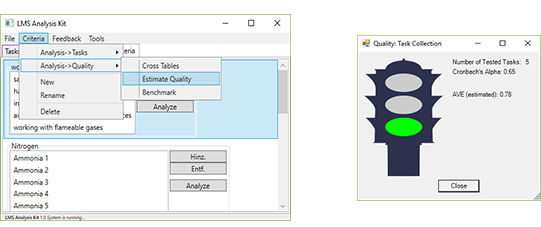Optimize Criteria
Not every set of tasks is suitable for predicting a student's learning progress within a LMS. Even with a pedagogically and didactically thought-out compilation of tasks, some compilations can only reflect a learning progress in an incorrect way. There are many causes for a bad suitability of a criterion for a prognosis: The competence behind the criterion has a hidden layer structure that distorts the prognosis; the learning goal is too complex for an analysis; or the thematic compilation addresses too many different aspects. In some cases, individual tasks may simply be inappropriate for the other tasks of the compilation. Therefore, after the first definition of the criteria, there must always be an evaluation phase following, in which the quality of the composition is checked and, if necessary, adjusted.
The editing functions within the Criteria tab offer various functions. If the Criteria tab is visible, the corresponding functions appear in the adaptive main menu.
The criterion to be checked must be marked, you just have to click on the corresponding criterion, so that it is completely blue. Subsequently, the quality can be examined and improved in the menu Criteria in the subsection Analysis-> Quality with different tools.
Cross Tab
The function Cross Tab generates a cross tab with all the tasks of the criterion. If the analysis method Cross Tab is selected, the result appears in a new tab in the form of a report. In this case, the relationships between the individual tasks are displayed in pairs in a table.
The LMSA Kit may use different measures of association for the cross tab:
- Quadrant correlation
- Spearman's correlation coefficient
- Pearson's product moment
- Covariance
If a report with a cross table is open, you can switch between the different coefficients using the report menu.
Cronbach's Alpha
The top entry of the report menu does not change the measure of association of the cross tab, it opens instead a dialog box in which the estimated value of the internal consistency (Cronbach's Alpha) can be seen. The bases are the cross tabs of Pearson or Spearman's correlation coefficients.
Beta: Automatic Criteria Optimization
The newest feature is the automatic optimization of the criteria. It should accompany teachers through the evaluation process of the defined criteria and it offers constructive suggestions for improvements. Teachers thus receive more active support during the development phase of the learning process evaluation. At the same time, the time required to develop the criteria can be reduced. A first trial version of this feature will be implemented in one of the next versions of the LMSA Kit.
